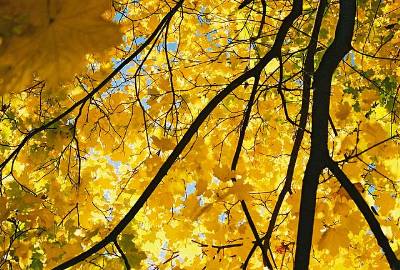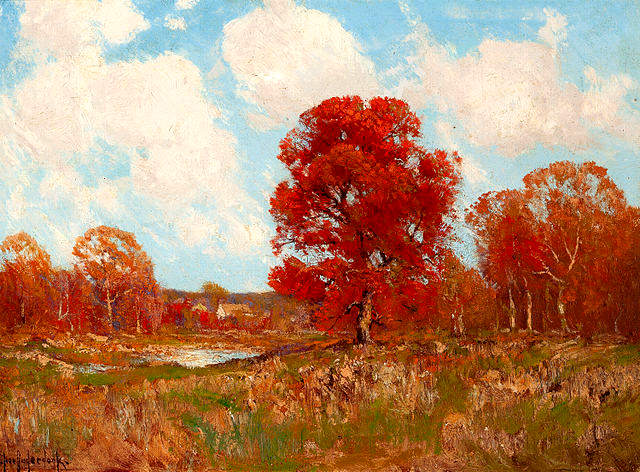Chromoplasts
Online Biology Dictionary
|
|
 Yellow Maple in Autumn
Yellow Maple in Autumn
Chromoplasts (/"KRŌM-ə-plasts"/) are plastids, other than chloroplasts, that produce and store pigments. Found in flowers, leaves, roots and ripe fruits, they contain carotenoids (lipid-soluble pigments ranging from yellow to red in color), which lend color to the plant tissues containing them. For example, it's the carotenoid pigment lycopene that makes a ripe tomato red, while
There are hundreds of carotenoids, each with its own characteristic color. Carotenoids are divided into two categories, those that contain oxygen (xanthophylls) and those that lack it (carotenes). Xanthophylls are yellow, while carotenes are orange. The xanthophylls violaxanthin and neoxanthin are responsible for making the flowers of a tomato plant yellow. The carrot is an example of a root that gets its bright orange color from carotenes, particularly β-carotene, as well as lesser amounts of α-carotene and γ-carotene (with a dash of lutein and zeaxanthin!). β-carotene is a precursor (inactive form) to vitamin A and is also found in sweet potatoes and pumpkins.
In many fruits, chloroplasts convert to chromoplasts as fruits ripen so that there is a change in color from green to red, orange or yellow (chloroplasts are plastids that engage in photosynthesis and therefore contain a high concentration of chlorophyll). On the other hand, when leaves turn in the fall, it is due to the loss of the green color of chlorophyll which reveals the reds, oranges and yellows that were there all along.
These pigments play a role in determining which pollinators visit any given type of flower. White blooms attract beetles, violet and bluish ones, bees. Butterflies tend to go for yellows and oranges. An incidental affect of these color differences, then, must be that pollinators will carry an increased percentage of pollen between like types of plants since their attentions are narrowed to a subset with flowers in a particular color range.
Very few animals can synthesize carotenoids, but, when ingested, these pigments do affect the color of various animal tissues such as egg yolk and body fat, lending them yellow and orange colorations.
Note: The word chromoplast is sometimes used to refer to any pigmented plastid, even a chloroplast. In this usage it is used in contrast to leucoplast, which have no pigments. So under this definition, chloroplasts would be one type of chromoplast. However, chromoplast is usually used to designate only pigmented plastids other than chlorophyll.

Most shared on Macroevolution.net:
Human Origins: Are we hybrids?
On the Origins of New Forms of Life
Mammalian Hybrids
Cat-rabbit Hybrids: Fact or fiction?
Famous Biologists
Dog-cow Hybrids
Georges Cuvier: A Biography
Prothero: A Rebuttal
Branches of Biology
Dog-fox Hybrids